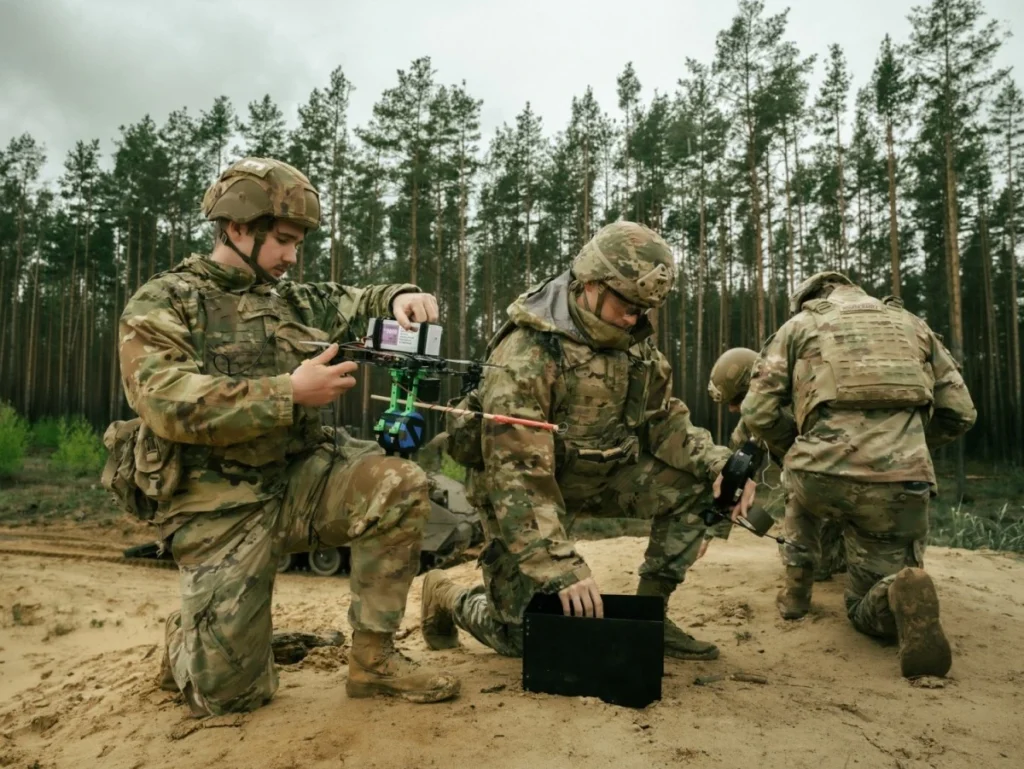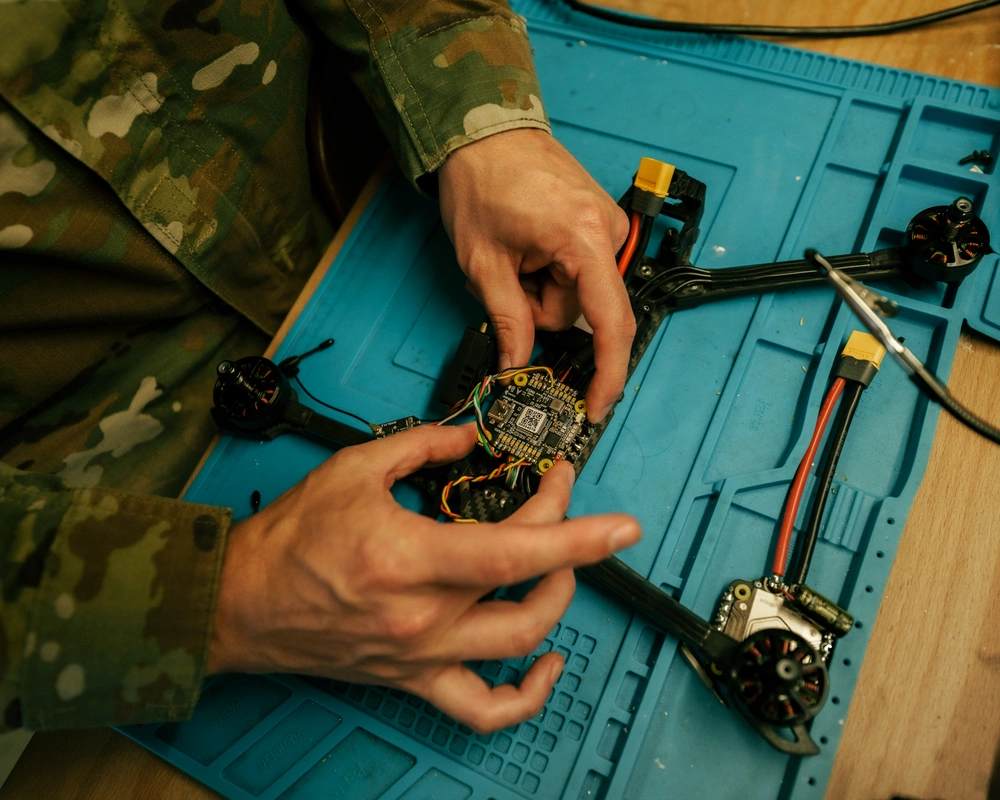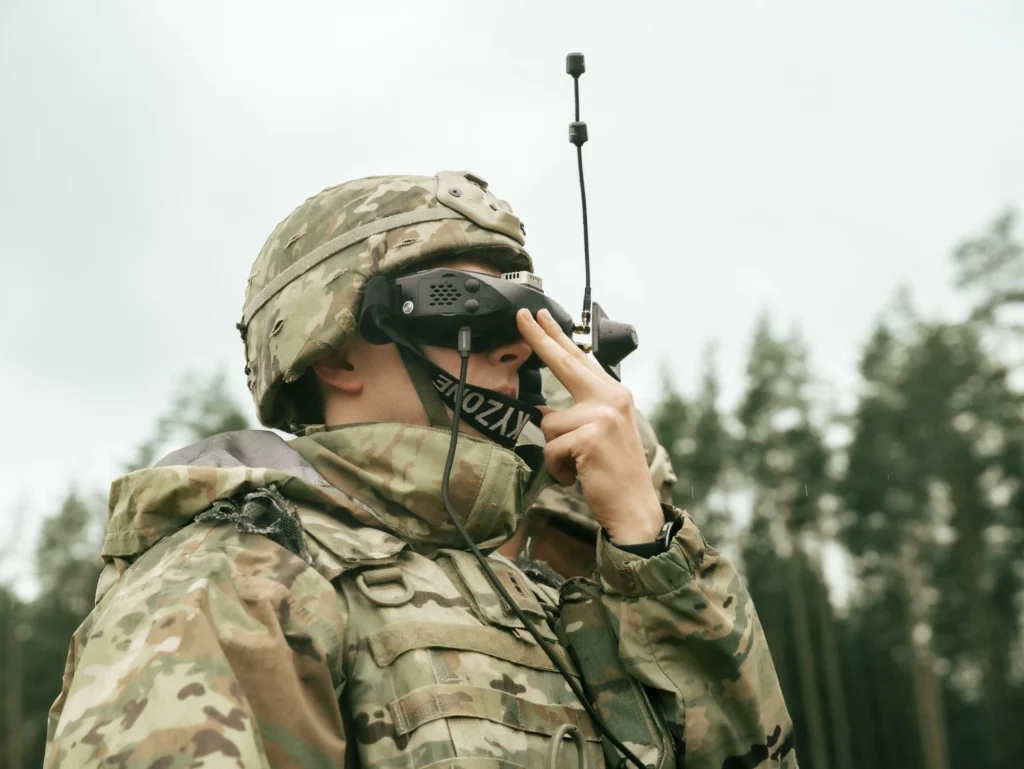Army marks first aerial drone-on-drone kill as new lethal UAS course gets underway
- By Hope Seck
Share This Article

In August, the Army marked another milestone in the integration of killer drones into the force when paratroopers with the 173rd Airborne Brigade destroyed an unmanned aircraft in flight using another aerial drone – a strike one participant likened to a scene from Star Wars.
For Maj. Wolf Amacker, who helped stand up the Army’s new unmanned aerial systems advanced lethality course, it’s a step toward the UAS capability he envisions for the whole fighting force.
“That’s the training and tactics we want to teach our students,” he told Sandboxx News. “Getting those tried and true people who have done the thing to come in and teach at the course, and then kind of going into what our course does, and where we think we’re strong, we’re trying to fill that need for the Army.”
The aerial UAS kill, at Fort Rucker, AL, involved a Skyraider first-person view, or radio-controlled. quadcopter drone, which took out a fixed-wing UAS being piloted by another soldier by detonating a claymore mine behind it in a mission the Army is calling “Project Shank.” Members of the 173rd and the Pennsylvania Army National Guard, who trained for weeks to master weather conditions and technique, emphasized that this wasn’t merely a successful strike: it was an unmanned dogfight.
“In [the Star Wars movie] A New Hope, Luke Skywalker flies an X-Wing through the Death Star trench and blows it up,” 1st Lt. Francesco La Torre, who was on the team that made the kill, said in a news release. “This wasn’t like that. It was way harder. Honestly, it felt more like Darth Vader shooting down rebel pilots. He might be the villain, but he’s also one of the best pilots in the galaxy.”
Amacker, who is also a tactics and UAS branch chief at the Army’s Aviation Center of Excellence, that doesn’t overstate the difficulty of the kill. In addition to the initial challenge of locating a small drone out in the battlespace in the first place, precise maneuvering with the FPV control was needed.

“Your pitch, your yaw, your role is controlled by the operator and FPV goggles,” he said. “And by being disconnected from the vehicle, there’s some sensations that you don’t get that you [would] normally get [while] flying that make it a little bit more difficult. And then it doesn’t auto correct naturally.”
In the acrobatic mode that UAS pilots are now engaging with these FPV drones, he said, operators can do many of the difficult maneuvers associated with fighter jets, from loops and spins to extreme pitching and banking, all without any physical contact with the aircraft itself.
These are skills Amacker wants to transmit to more units.
“We are trying to close this gap on using lethal means with a small UAS, because we’re familiar with how to do it with a larger UAS,” Amacker told Sandboxx News, referring to the MQ-1C Gray Eagle, the MQ-9 Reaper, and other large drones that can be programmed to stay on station at altitudes of up to 50,000 feet until they are tasked with striking a target.
“When we transitioned away from that, going to these quadcopters that are seeing a lot of effectiveness within different battlefields out there – Ukraine, Gaza – we are trying to take techniques, tactics and procedures that are being learned out there, and then quickly apply them into the classroom and show our students how they can use the different pieces of equipment.”
It now takes about 25-30 hours, he said, to become proficient in the maneuvers needed to conduct these lethal small UAS missions.
Related: Army seeks information about miniature aircraft that can take out drones

Amacker and co-director Capt. Rachel Martin were tasked in April with launching a pilot lethal drone course. They graduated their first 28 students from the 15-day course on August 22; they are now preparing to run a second iteration in mid-October. Chief Warrant Officer 2 Nathan Shea, who executed the historic drone-on-drone strike, is in talks to return to Rucker and help teach the course. The hope, Amacker said, is to run eight courses a year, with an annual throughput of around 250 students.
And, he said, they want to get bigger. While the course so far has been operating only Group 1 drones – the smallest category – he’s looking to acquire a Group 2 or 3 vertical takeoff and landing drone “that can kind of replicate a higher level of intelligence, surveillance, reconnaissance asset that we can show the students how that ties into their mission, how that all works together for them to go out and conduct a strike.”
Amacker acknowledged that the Army is moving fast to catch up with technology already being employed in real-world battlefields, and said the lethal UAS course would serve to help the work have a cumulative effect.
“So every unit is trying to do it, and what I really hope we can help with in this course is tying all those efforts together and synchronizing those efforts so that if someone learns a hard lesson on how not to do something at Fort Bragg, we can learn that lesson and share that lesson so that they don’t have to learn it in Hawaii or Fort Wainwright [Alaska],” he said.
Feature Image: U.S. Army paratroopers assigned to the 173rd Airborne Brigade prepare to operate and detonate a live First Person View (FPV) drone at Pabradė Training Area, Lithuania, during a joint forcible entry operation as part of Swift Response 2025, May 18, 2025. (U.S. Army photo by Sgt. Jose Lora)
Read more from Sandboxx News
- Britain starts construction of its final Dreadnought class nuclear submarine
- The Pentagon wants a highly capable nonlethal weapon for drug boat interdiction
- Russian Air Force increases violations of NATO airspace
- SWCC are the Naval Special Warfare’s elite boat operators
- F-22 achieves record-breaking shot with Raytheon’s newest AIM-120 missile
Related Posts
Sandboxx News Merch
-

F-35 ‘Evolution’ Poster
$22.00 – $28.00Price range: $22.00 through $28.00 Select options This product has multiple variants. The options may be chosen on the product page -

A-10 ‘Thunderbolt Power’ Framed Poster
$45.00 – $111.00Price range: $45.00 through $111.00 Select options This product has multiple variants. The options may be chosen on the product page
Hope Seck
Hope Hodge Seck is an award-winning investigative and enterprise reporter who has been covering military issues since 2009. She is the former managing editor for Military.com.
Related to: Gear & Tech

All the bonuses and benefits for troops in the new defense budget

The Marine Corps’ best Christmas present was a new class of landing ships
Sandboxx News
-

‘Sandboxx News’ Trucker Cap
$27.00 Select options This product has multiple variants. The options may be chosen on the product page -

‘AirPower’ Classic Hoodie
$46.00 – $48.00Price range: $46.00 through $48.00 Select options This product has multiple variants. The options may be chosen on the product page -

‘AirPower’ Golf Rope Hat
$31.00 Select options This product has multiple variants. The options may be chosen on the product page -

‘Sandboxx News’ Dad Hat
$27.00 Select options This product has multiple variants. The options may be chosen on the product page

